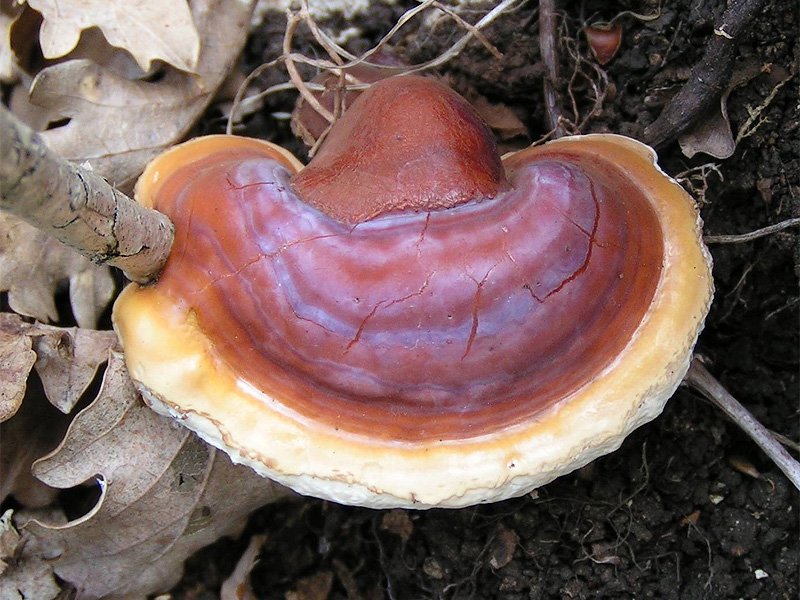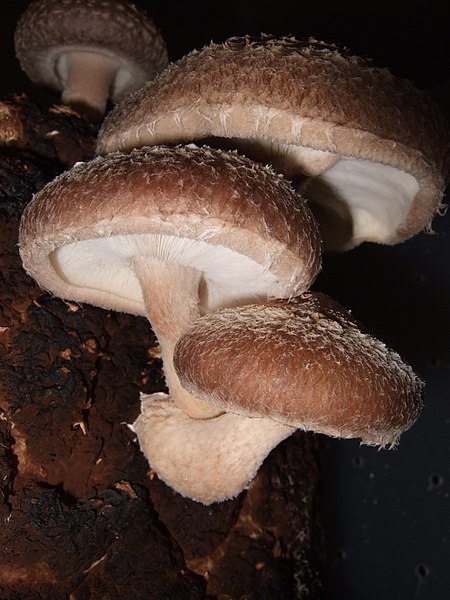Medicinal Mushrooms
Throughout history mushrooms have been used as food and medicine by nearly every culture. Modern science has conducted numerous studies on the efficacy of mushrooms when used in the treatment of various cancers and a myriad of other diseases with excellent results! The scope of this article could not even begin to approach the broad spectrum of mushrooms available for medicinal use (there are over 38,000 known species of mushrooms!), nor the range of their medicinal factors, so I will attempt to cover the basics of the medicinal mushrooms that are currently used in the treatment of cancer. There happen to be several of them, which I will list, but the focus of this article will be on the Big Three: Reishi (Ganoderma lucidum), Shiitake (Lentinula edodes) and Maitake (Grifola frondosa).
A mushroom is the above-ground reproductive aspect of a larger organism. The fruiting body called a mushroom produces spores that are easily distributed by wind. The underground aspect is called the mycelium, a threadlike structure that can spread for miles in some instances. The mycelium generally feeds on decomposing organic matter and often shares a symbiotic relationship with its host plant, tree or environment. When attached to the roots of some plants or trees, it often will make nutrients more bio-available to the plant, while in return receiving nutrition from its host. Fungi also do a great service for their entire environment, breaking down organic matter and adding richness to the soil. Plants will frequently thrive in an environment where fungi are naturally present; they are a necessary aspect to a healthy eco-system. Some species of fungi actually parasitize their host-plants, insects and other animals. This non-toxic and cutting–edge technology is now being utilized by a few environmentally conscious exterminators to infect certain pests by setting out traps of inoculated bait that quickly dispatches the entire colony.
Superficially speaking, the attributes of mushrooms could be considered clues to their benefits on human health. Their ability to transform organic matter hints at their ability to transform toxins in the body. The manner in which they appear to grow quickly and seem to materialize from nowhere suggests a similarity to the properties of cancer, for which mushrooms are famous for treating effectively.
Mushroom are cellulose based organisms that contain polysaccharides, terpines, steroids and other compounds, many of which show great promise in the treatment of cancer. Polysaccharides, shown in many studies to be anti-tumor, are large molecules with an above average molecular weight which resemble molecules found in bacterial cell membranes. Because of this, their presence in the body creates various immune responses like an increase in the production of killer T-cells and macrophages (specialized white blood cells with strong immune functions). The nutritional content of mushrooms is wide and variable, but most contain significant amounts of protein, essential amino acids, essential fatty acids (EFA’s), vitamins such as biotin, C, niacin, riboflavin, thiamine and occasionally beta carotene, as well as minerals like sodium and phosphorus and moderate amounts of iron and calcium.
Reishi
(Ganoderma lucidum) also known as Ling zhi, has a rich history- over 4,000 years- particularly in Asia where it was widely sought after and highly valued. Emperor Ti, the first emperor of China (Chin dynasty- 221 BCE), ordered a fleet of ships to sail the seas of the East in search of this valuable “mushroom of immortality.” The reishi was credited with not only conferring long life, but also great health and stamina. The Taoist sages leaned upon staffs carved from the hard shelf-like mushrooms that increased memory, nurtured the Spirit and calmed the mind. Today, the reishi mushroom is valued mostly for its anti-cancer properties. Ganoderma contains germanium, a compound that increases oxygen utilization in the cells and protects against free-radicals; it has several other active constituents, including Beta-D-glucan, that are anti-tumor, immunostimulating, build the bone marrow, cleanse liver toxins, are antihistamine and the list goes on.
Shiitake (Lentinula edodes) is a delicious gourmet treat commonly available in the produce section of most grocery stores-a word to the wise: non-organic mushrooms available as produce are heavily sprayed and best avoided. This well-recognized edible mushroom is the subject of vast amounts of research in Japan and the US for its anti-tumor properties. This is mostly due to the exciting results shown from the protein-bound polysaccharide Lentinula edodes mycelium (LEM) and the polysaccharide Lentinan. Studies have shown dramatic degeneration of tumor cells, an increase in white blood cell, interferon and antibody production, as well as assisting patients with HIV and AIDS and various forms of hepatitis. This is one of the most widely cultivated mushrooms in the world, second only to the button mushroom (Agaricus bisporus), and though not native to the US, can be cultivated with growing kits indoors or out.
 |
| I definitely danced with joy for this haul! |
Maitake
(Grifola frondosa) is also known as “hen of the woods;” it’s Japanese name translates as “dancing mushroom,” reputedly because its value was worth its weight in silver and anyone who found it would dance with joy. It remains quite valuable and mushroom hunters guard their secret locations vigilantly-not even to divulge their whereabouts to family members! Techniques for cultivation were introduced in the late 1970’s, so Maitake is now much more widely available for food and medicine. Maitake is delicious; it is a tender mushroom that enhances any savory dish. Therapeutically, it is a source of potent anti-tumor and immune stimulating compounds that increase immune function and inhibit tumor growth, proliferation and metastasis. Several promising studies have been done on Maitake D-fraction which is available at most health food stores.
 |
| Turkey Tail |
 |
| Oyster cluster - L. Huebner |
|
There are many more mushrooms used as medicine available commercially. Turkey Tail
(Coriolus versicolor a.k.a.
Trametes versicolor), found in the popular Essiac (and Cassie’s) tea, is antibiotic and immune-stimulating. Studies at Sloan Kettering on the fruiting body of Porcini
(Boletus edulis) have shown anti-cancer and anti-tumor activity, especially when used preventatively. A peptide or protein found in this bolete may be responsible for the inhibition rate of 90% against Ehrlich carcinoma and the 100% inhibition rate against sarcoma 180. The gourmet Oyster mushroom
(Pleurotus ostreatus), Porcini (also known as Cep or King Bolete), Chanterelle
(Cantharellus cibarius), Morel
(Morchella esculenta and
M. deliciosa) and the Fried Chicken Mushroom
(Lyophyllum decastes/Tricholoma aggregatum/Clitocybe multiceps) have all been shown to inhibit tumor growth and to taste extraordinarily scrumptious! Even the boring old standby, the button mushroom has anti-tumor properties.
 |
| Chanterelle - L.Huebner |
 |
| Morel - L.Huebner |
Medicinal and epicurean mushrooms may be purchased fresh, dried, powdered, tinctured or in capsules and tablets from natural food stores, gourmet grocers, qualified health care practitioners and are widely available online. Be sure to research the quality of the brand you choose, or you can start cultivating your own mushrooms to really build an intimate relationship with your friendly fungi! Another option is to learn how to identify and forage for your own wild mushrooms by joining a local mycological group (mushroom foraging clubs that have experts on hand) and purchasing an excellent field guide! Never ingest any wild mushroom when in doubt about its identity; some look-alikes may be toxic or even deadly. Don’t let that scare you off too much though, with spore prints and frequent, careful observation, many species of delicious and healthy mushrooms are easy to identify positively.
The author can frequently be found with a flat-bottomed basket and a supply of paper bags in forests throughout the area gathering up her favorite wild gastronomic treats-some to enjoy right away sautéed in a little butter, more to dry for future food and medicine. Please don’t ask me where to find the Maitake or the Morels; it’s a secret I’ll never divulge!
Lisl Meredith Huebner, Dipl.CH (NCCAOM), RH (AHG) is a nationally board certified Chinese Herbalist, and a Registered Herbalist with the American Herbalists Guild. Lisl is also a certified Medicinal Aromatherapist, a level III Reiki practitioner, an Acupressurist, an Auriculotherapist, a photographer, a renowned diagnostician, a teacher and a published writer in private practice for over a decade. She is available by appointment.
Please call 8 6 0 - 4 8 0 - 0 1 1 5 or email HerbaLisl@hotmail.com if you have any questions, would like to schedule an appointment, attend meditations, weed walks, or are interested in taking classes.












Mycology - definitely an under-studied aspect of Herbalism (but that is because they are not even in the same KINGDOM hehe)! :-) Love your article Lisl!!
ReplyDeleteThanks my Sister Cappy!!
ReplyDeleteI love your blogs and website! Andrea from Hungary
ReplyDeleteWow! I forwarded this info to my friend.I love hearing about how intelligent and how helpful these mushrooms are. Helpful litle fellas!! Also, I was wondering I harvested a reishi mushroom. How would I preserve it and how much would I take to make tea or is there a good way to make the tea from a whole mushroom? PS-I had someone knowledgable show what reishi's look like. So I am pretty sure I am good. I want to actually gift it to a friend that seems could benifit after reading of the healing effects of reishi. Thanks for the informative blog!!
ReplyDeleteABSOLUTELY make sure that you have the correct mushroom. Water decotions are the best way in my opinion, to get the benefit from mushrooms! You could also opt to put it in the pot while simmering stock! I have a post "Making Your Own Medicine Benefits Everyone" that explains the process of making a decoction. You're a good friend to offer such a valuable gift of health!
DeleteI like this! So simple and so delicious! I have a bunch of mixed mushrooms that I guess I could toss together. Yum!
ReplyDeletespore syringe